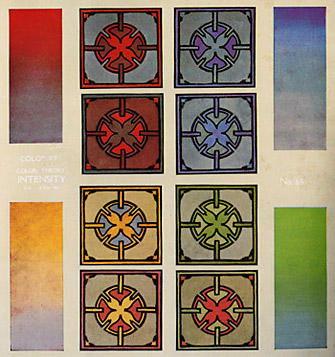Deerfield Arts & Crafts home page
Comparisons
Harmonious Design through Artistic Choices


Quality design was of key interest to Arts and Crafts artisans, and we know that Deerfield's artists were aware of larger national trends. A hallmark of Blue and White needlework is the harmony and visual interest that each piece unfailingly achieves, often with a design that balances similar, rhythmically-arranged compositional elements. In just one of a number of Ellen Miller's pomegranate designs, the artist has oriented four, nearly-identical motifs into a larger square so that a trio of the stylized fruit nestles into each corner of the work. Four rope stems extend toward the center of the piece, coming to rest at the Society's seal in the middle. Miller's design is nearly symmetrical along its vertical and horizontal mid-lines. A subtle balancing of light and dark hues adds to the harmony of the whole. In A Theory of Pure Design published in 1907, painter and Harvard professor Denman Waldo Ross illustrates just this sort of arrangement of inverted common elements around horizontal and vertical midlines with the aim of achieving visual harmony. Arthur Wesley Dow demonstrates a similar technique for harmonizing a square composition with line, mass and color in several illustrations from Composition: A Series of Exercises in Art Structure for the use of Students and Teachers, first published in 1899 with color examples, such as the one shown above, added to the 1913 edition.
Left image: Pomegranate Square, Ellen Miller, Memorial Hall Museum, Pocumtuck Valley Memorial Association
Right image: Colorplate from Composition, Arthur Wesley Dow, Memorial Hall Museum, Pocumtuck Valley Memorial Association